It’s Trans Awareness Week, the week leading up to Trans Day of Remembrance on November 20th. When we say that Autostraddle is website primarily for queer women, we want to be 100% clear that that includes queer trans women and that it’s important to honor trans women year-round, not just in obituaries. So all week long we’re going to be spotlighting articles by and about trans women, with a special focus on trans women of color. We hope you’ll love reading everything as much as we’ve loved writing and editing it.
It seems like when people talk about early trans pioneers from history we only ever hear two names — Lili Elbe and Christine Jorgensen. Things are getting better and now we also talk about TWOC leaders like Sylvia Rivera and Marsha P. Johnson. While it’s true that Elbe and Jorgensen are important historical figures, and while it’s true that Rivera and Johnson are legends who we owe worlds to, it’s also important to talk about other trans women who might be less well-known, but have had their own big impact on trans history.
It’s usually pretty suspect to prescribe modern identities to people from the past, but no matter which way the deceased people on this list would identify if they were alive today, they remain important figures in the history of American (and some international) trans and gender non-conforming people and the way people challenge society’s rules for gender. This list is only the tip of the iceberg; there are dozens and dozens of other trans pioneers without whom we wouldn’t be here today.
As a general warning, some of the pages I’m going to link to contain misgendering and/or outdated terminology.
1. Mary Jones
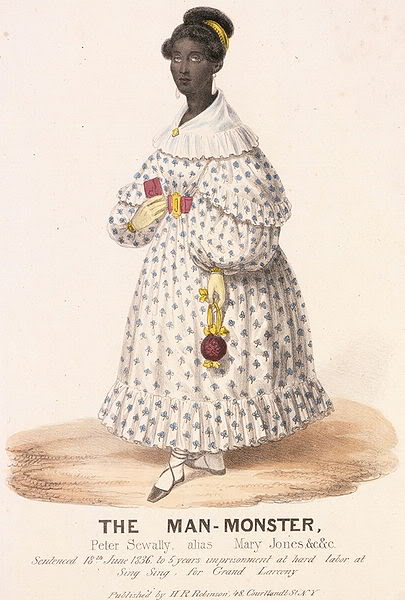
A really transmisogynistic lithograph printed in New York newspapers during Jones’ trial.
Our first figure comes all the way back from 1836. Mary Jones was a Black sex worker in New York City whose story is one of the earliest that we have of a trans woman in the United States of America. In the summer of 1836, Jones was arrested after a male client slept with her. You see, she wasn’t just a sex worker, she was also a pickpocket, and had stolen $99 (which would be at least $2,600 in today’s money, you go girl) from a white mason worker named Robert Haslem. When she was arrested, the police searched her and discovered that she wasn’t a cis woman. Jones’ trial quickly became the talk of the town, as she appeared in court dressed as a woman in elegant clothing (natch) and explained to the court, “I have always attended parties among the people of my own Colour dressed in this way — and in New Orleans I always dressed in this way.” She also apparently was able to trick men into thinking they were having sex with a cis woman because she “had been fitted with a piece of cow pierced and opened like a woman’s womb, held up by a girdle.” So either men in the 1830s were exceptionally clueless about women’s bodies or they would take any excuse they could find to explain why they were having sex with a trans woman. Or probably both. The court was, unsurprisingly, very horrible towards her, laughing, pointing and even snatching off her wig at one point. She was finally sentenced to five years in state prison for Grand Larceny.
2. Frances Thompson
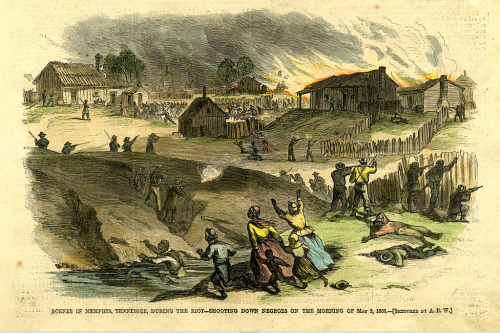
A depiction of the Memphis Riots.
Thompson, a former slave, is quite possibly the first trans woman to testify before a congressional committee in the United States. In 1866 she testified before a committee investigating a riot that had occurred in Memphis, Tennessee. For three days in May of 1866, white men rioted throughout a community of emancipated slaves in Memphis. At least 48 African Americans were murdered, with close to 80 more injured, and five women testified to being raped. She testified that seven white rioters had broken into the house that she shared with another former slave, Lucy Smith. After the men demanded that they find “some women to sleep with,” they raped Thompson and Smith. Ten years later, Thompson was arrested for “being a man dressed in women’s clothing.” Her arrest for “transvestism” was used by newspapers in Memphis to smear her name discredit her story that she was raped.
3. Lucy Hicks Anderson
Born in 1886, Lucy Hicks Anderson is one of the earliest fighters for marriage equality in the United States. She grew up in Kentucky, where she started presenting as a girl and going by the name Lucy at an early age. She later moved to Texas, then to New Mexico, where she married Clarence Hicks, then to California where she lived in Oxnard and operated a brothel. After divorcing Hicks in 1929, she married Reuben Anderson, a soldier, in 1944. Her signing of this marriage licence led to a perjury charge against her, as on it she swore that there were “no legal objections” to the marriage. She told reporters, “I defy any doctor in the world to prove that I am not a woman. I have lived, dressed, acted just what I am, a woman.” Still, she was found guilty of perjury and later fraud because she received allotment checks as the wife of a US Army soldier.
4. Coccinelle (Jacqueline Charlotte Dufresnoy)
Coccinelle (the French word for ladybug) was the professional name of Dufresnoy, a French actress, entertainer, singer and activist, and one of the first people to undergo a widely publicized successful gender confirmation surgery in Europe. Born in Paris in 1931, Dufresnoy began taking hormones in 1952 and made her debut as a showgirl the next year. She quickly became popular and soon joined other famous trans showgirls April Ashley, Marie-Pierre Pruvot and Amanda Lear as a regular at the Le Carrousel de Paris nightclub. She became so popular that she was featured in several films, had an Italian singer, Ghigo Agosti, dedicate a song to her, and starred in her own revue, “Cherchez la Femme.” After she underwent her operation, France changed its laws to allow for changes to be made on birth certificates following gender confirmation surgery. Her first marriage was also established trans people’s right to marry in France. She also founded the trans support group Devenir Femme and helped establish the Center for Aid, Research and Information for Trnassexuality and Gender Identity.
5. Louise Lawrence

Louise Lawrence with cigarette. Courtesy of Kinsey Institute, Indiana University
Lawrence began living full-time as a woman in the 1940s in San Francisco. There she worked as an artist and the manager for an apartment building for women, where she lived with her partner, a woman named Gay. In the following decade she created a widespread correspondence network with other transgender people throughout the US and Europe that laid the groundwork for Virginia Prince’s eventual Transvestia magazine subscription list. Lawrence worked with both Alfred Kinsey and Dr. Harry Benjamin on their work with trans people. Her work to connect trans people across the world was extremely important in the creation of trans organizations and communication in a time when those things didn’t really exist.
6. Carlett Brown

Carlett Brown on the cover of Jet Magazine.
Shortly after Christine Jorgensen got her much publicized gender confirmation at the end of 1952, another woman, Carlett Brown sought to undergo a similar procedure. Brown was an African American Navy vet who was working as a female impersonator and “shake dancer” in nightclubs. While in the Navy, she had discovered that she was intersex, and while the doctors suggested that she have surgery to become more “typically male,” she instead decided that she wanted to undergo the same operation Jorgensen did. She ran into a problem when she discovered that the nations who offered the surgeries she was seeking didn’t allow foreign nationals to undergo the surgery. Her plan was to travel to Europe and renounce her US citizenship, saying “I just want to become a woman as quickly as possible, that’s all. I’ll become a citizen of any country that will allow me the treatment that I need and be operated on.” However, before she could leave the country she was first arrested because of an anti-crossdressing law and then later not allowed to leave because she was ordered to pay $1,200 in back taxes. Her story was chronicled in Jet Magazine, which also featured Sir Lady Java, and after she was ordered to pay the back taxes, her story went cold.
7. Sir Lady Java
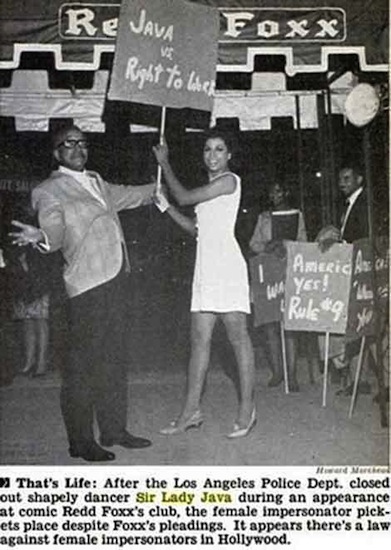
Sir Lady Java protesting at Redd Foxx’s club in Jet Magazine.
Born and raised in New Orleans, Java later moved to Los Angeles where she became a sensation due to her 38-24-38 curves, singing, impersonations and dancing. Rumor has it that she dated Redd Foxx and Sammy Davis, Jr. She publicly challenged the city’s “Rule No. 9,” the law that banned crossdressing, when she worked at legendary comedian Red Foxx’s club in LA. LAPD threatened to shut down Foxx’s club, and so Java’s act was cancelled. In 1967, however, she worked together with the ACLU to argue that the law was unconstitutional and that it was preventing her from earning an income. The legal challenge was thrown out, however, due to a technicality, but was covered by Black and gay publications, drawing important attention to the discriminatory law. Sir Lady Java is still alive today.
8. Crystal LaBeija
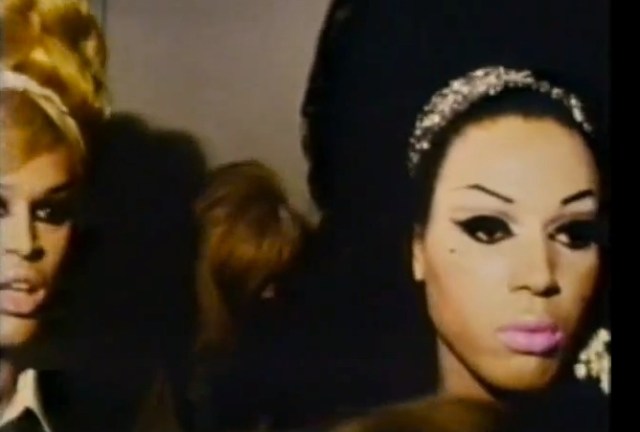
Crystal LaBeija in The Queen
The founder of the House of LaBeija, perhaps the first house in the New York Ball scene, The Legendary Crystal LeBeija is famously featured in the 1968 documentary The Queen and even makes an appearance in the opening credits of the Amazon Prime show Transparent. This documentary shows the 1967 Miss All-American Camp Beauty Pageant where LaBeija called out the host, Flawless Sabrina, saying that the ball was racist and fixed, after a white Queen, Rachel Harlow, was declared the winner. She founded the House of LaBeija in 1970 or 1972 when another drag queen, Lottie, asked her to promote a ball with her. LaBeija agreed when “Lottie made the deal sweeter by convincing Crystal that they should start a group and name it the House of LaBeija, with Crystal’s title as ‘mother.'” It may have been something of a PR stunt, but it started a revolution.
9. Angie Xtravaganza
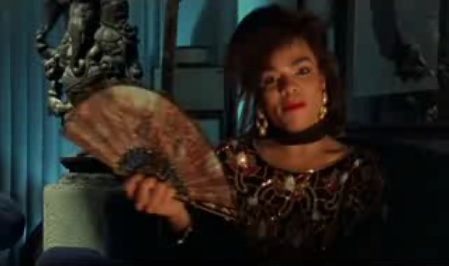
Angie Xtravaganza in Paris is Burning.
The longtime Mother of the Legendary House of Xtravaganza, the first primarily Latina House in New York’s Ballroom Scene. She was featured in the documentary Paris is Burning, where she was awarded a Mother of the Year trophy, talked about her House and her children. When she founded the House of Xtravaganza she was the youngest of the legendary mothers, a group containing herself, Pepper LaBeija (who took over after Crystal), Avis Pendavis, Dorian Corey and Paris Dupree. She died in New York at the age of 27 from AIDS complications and liver disease. She remained a mother up until the very end, and towards the end of her life she liked to say, “I have no regrets. No drag queen has carried herself the way I have. I’m not a beauty, but I’ve got class.”
10. Dorian Corey
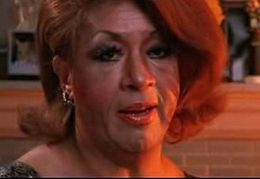
Dorian Corey in Paris is Burning.
Dorian is the guiding voice of Jennie Livingston’s Paris is Burning, laying down the law about shade, fame, beauty, houses and life in general, all while casually putting her face on. Outside of Paris, she was the mother of the House of Corey and was a Legendary participant in the balls of New York where she was famous for her extravagant costumes and won over 50 grand prizes throughout her life. She gives the poignant final lines of Paris, saying, “I always had hopes of being a big star. But as you get older, you aim a little lower. Everybody wants to make an impression, some mark upon the world. Then you think, you’ve made a mark on the world if you just get through it, and a few people remember your name. Then you’ve left a mark. You don’t have to bend the whole world. I think it’s better to just enjoy it. Pay your dues, and just enjoy it. If you shoot a arrow and it goes real high, hooray for you.”


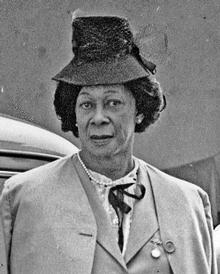
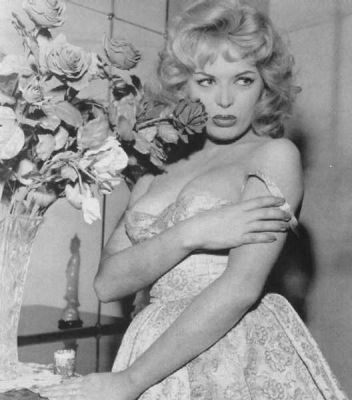

Thank you for this history!
thank you for this, mey x
Wow, so many amazing and badass women! Thanks for putting this together :)
fun fact: they found a body in dorien corey’s possessions after her death. Suspected to be a trick gone wrong. homegirl didn’t play lol.
Thank you. This was interesting and educational to read.
Not a WOC, but during WWII, an ex-RAF officer named Margaret Bruce took part in an effort by British witches and occultists to hamper the Axis forces through magick. Margaret was a perfumer and ran an animal sanctuary with her partner. Not much info exists about her, I heard of her during a lecture by RJ Stewart who was a personal friend. I did come across this blog post that has an excerpt from one of her pamphlets, though.
http://blacknyx.tumblr.com/post/4823116156/magick-and-the-supernatural
“she had been fitted with a piece of cow pierced and opened like a woman’s womb, held up by a girdle.” is definitely not a sentence i expected to hear today, but you know what, i’m glad that i did.
this was so interesting! knowing history like this is just so important
Right? When I got to that part I had to stop and make sure I read it right!
Thank you do much for unearthing the stories of these trans woman of color.
This is awesome, Mey! Thank you for writing it. I had only heard of a couple of these women previously. For some reason, it’s incredibly reassuring just to be able to say, “Look, we’ve been here all along.”
Thanks so much for this!
this is so awesome, thank you so much!
What badasses. I started writing a comment thanking you for writing about my favorite, and then I decided I had two favorites, and then that became the entire list. They are all awesome.
If you’re interested in exploring more of these biographies from trans/queer history, I highly recommend “Gender Variance Who’s Who.” One of the best blogs out there with an incredible archive of information. http://zagria.blogspot.com/
The other blog is Monica Robert’s Transgriot, which also regularly features posts about the past and present of trans women of color: http://transgriot.blogspot.com/
For those of you who are francophones, http://www.dianeetlesexedesanges.ch/3colset008/_page_album_stars.htm
is an amazing site about trans women and other gender variant performers mostly
from the French world. Incredible photos from the 1950s-70s.
Lastly, Queer Music Heritage is a site concerning the entire LGBTQ community. He has a backlog of shows with some amazing interviews, sound pastiches and obscure queer culture songs on it. http://www.queermusicheritage.com/index2.html
Yeah! I link to both Transgriot and the Gender Variance Who’s Who a few times each in this article, they were super helpful!
I’m so happy to see content that celebrates and educates in the lead-up to TDOR, which is (by nature) more focused on mourning and anger etc. This history is so interesting!
This is excellent!
Great article–thank you, Mey!
Thank you so much for sharing the stories of these amazing women.
You are a wonderful contributor to this site. Very cool article. I am also both fascinated and grossed out with the cow situation.
I know I’ve brought her up before, but I don’t think any list like this is complete without mention of Eleanor Rykener, who precedes all of these women by at least 500 years:
http://www.fordham.edu/halsall/source/1395rykener.html
“The Questioning of John Rykener 1395: Translation
On 11 December, 18 Richard 11. were brought in the presence of John Fressh, Mayor. and the Aldermen ofthe City of London John Britby of the county of York and John Rykener., calling [himself] Eleanor, having been detected in women’s clothing, who were found last Sunday night between the hours of 8 and 9 by certain officials of the, city lying by a certain stall in Soper’s Lane committing that detestable unmentionable and ignominious vice. In a separate examination held before the Mayor and Aldermen about the occurrence, John Britby confessed that he was passing through the high road of Cheap on Sunday between the abovementioned hours and accosted John Rykener, dressed up as a woman, thinking he was a woman, asking him as he would a woman if he could commit a libidinous act with her. Requesting money for [his] labor, Rykener consented, and they went together to the aforesaid stall to complete the act, and were captured there during these detestable wrongdoings by the officials and taken to prison. And John Rykener, brought here in woman’s clothing and questioned about this matter, acknowledged [himself] to have done everything just as John Britby had confessed. Rykener was also asked who had taught him to exercise this vice, and for how long and in what places and with what persons, masculine or feminine, [he] had committed that libidinous and unspeakable act. [He] swore willingly on [his] soul that a certain Anna, the whore of a former servant of Sir Thomas Blount, first taught him to practice this detestable vice in the manner of a woman. [He] further said that a certain Elizabeth Bronderer first dressed him in women’s clothing; she also brought her daughter Alice to diverse men for the sake of lust, placing her with those men in their beds at night without light, making her leave early in the morning and showing them the said John Rykener dressed up in women’s clothing, calling him Eleanor and saying that they had misbehaved with her. [He] further said that certain Phillip, rector of Theydon Garnon, had sex with him as with a woman in Elizabeth Bronderer’s house outside Bishopsgate, at which time Rykener took away two gowns of Phillip’, and when Phillip requested them from Rykener he said that [he] was the wife of a certain man and that if Phillip wished to ask for them back [he] would make [his] husband bring suit against him.
Rykener further confessed that for five weeks before the feast of St. Michael’s last [he] was staying at Oxford, and there, in women’s clothing and calling himself Eleanor, worked as an embroideress; and there in the marsh three unsuspecting scholars – of whom one was named Sir William Foxlee, another Sir John, and the third Sir Walter – practiced the abominable vice with him often. John Rykener further confessed that on Friday before the feast of St. Michael [he] came to Burford in Oxfordshire and there dwelt with a certain John Clerk at the Swan in the capacity of tapster for the next six weeks, during which time two Franciscans, one named Brother Michael and the other Brother John, who gave [him] a gold ring, and one Carmelite friar and six foreign men committed the above-said vice with him, of whom one gave Rykener twelve pence, one twenty pence, and one two shillings. Rykener further confessed that [he] went to Beaconsfield and there, as a man, had sex with a certain Joan, daughter of John Matthew, and also there two foreign Franciscans had sex with him as a woman. John Rykener also confessed that after [his] last return to London a certain Sir John, once chaplain at the Church of St. Margaret Pattens, and two other chaplains committed with him the aforementioned vice in the lanes behind St. Katherine’s Church by the Tower of London. Rykener further said that he often had sex as a man with many nuns and also had sex as a man with many women both married and otherwise, how many [he] did not know. Rykener further confessed that many priests had committed that vice with him as with a woman, how many [he] did not know, and said that [he] accommodated priests more readily than other people because they wished to give [him] more than others.”
See also:
https://australianmedievalists.wordpress.com/2014/09/27/eleanor-rykener-and-queer-history/
and
https://australianmedievalists.wordpress.com/2014/09/28/the-erasure-of-eleanor-rykener-a-case-study-in-trans-and-bi-phobia/
“28/09/2014
The Erasure of Eleanor Rykener: A Case Study in Trans- and Bi- Phobia
Yesterday, we had primary source storytime, featuring the oft-ignored Eleanor Rykener, trans woman, prostitute, and (loosely speaking, allowing for anachronism etc) bisexual. The fact that the Rykener case has been recounted and analysed since its publication in 1995 as that of a ‘male crossdressing prostitute’ is, I concluded, incredibly reductive.
Allow me to revise that. It’s not just reductive. It’s outright transphobic, and the fact that no one has revisited the case in peer reviewed medieval scholarship is a shame to the field.” [More at link]
So interesting! Thank you for this!
Okay, but you’re leaving out the most bizarre/amazing story about Dorian Corey… how she had a mummified body in her apartment which got there under very mysterious circumstances: http://www.jstor.org/stable/2935316?seq=1#page_scan_tab_contents
Jan Morris! She summited Everest before transitioning and wrote a book called Conundrum. She’s a Welsh republican (very different to US Republicans!) and is generally awesome, Written lots of books and was a jounralist. https://en.wikipedia.org/wiki/Jan_Morris
Oh cool! I learned a lot from this. Thanks Mey!
You missed Canary Conn
i just learned so many things! thanks mey!
Amazing, thank you for posting. I wish hollywood would get hold of a few of these movies and give us some proper films representing trans life.
Loving this! Amazing and inspirational. Thank you.
This was incredible! So many badasses in this epic roundup. Cherchez la Femme!
Their opinion is that the M treatment should be used only to produce road going racers like the
original E30 M3. “Tycoon” was the last book released (in December 2005).
The quality, the performance and the overall experience is well
worth the price.
It might be worth noting that after Dorian Corey died, the mummified corpse of her notoriously abusive ex-boyfriend was found in a trunk in her apartment. He had been missing for over a decade. That alone inspires me about her, tho those who require one’s heros to be law-abiding will probably disagree.
Also, Coccinelle was a mentor to April Ashley, among others. If anybody joined anybody in Le Carrousel it was them joining her.
Mey this is amazing and I’m so furious I never learned about these women! I’m so excited to learn more!
This was great, thank you.
Aw, no Wendy Carlos?
Hey Mey, that’s a great list but you mention Amanda Lear being a famous trans showgirl so I got real confused for a bit (because for my 29 years of existence on this planet, people have said she was trans and she’s always refuted that) and thought wow she came out and googled her but nope… she never came out so, unless I’m missing something, she’s not trans, y’all.
Missed canary Conn
Great article! Glad I now know this! ;0)
I know I’ve read this before, but I’m coming back around to it since Trevor Project linked it from facebook. A great piece, though I have to admit I’m not even familiar with 3/4 of the names you mentioned in the preface (Lili Elbe, Christine Jorgensen, Sylvia Rivera–but I will look those up on my own time). But I was wondering if someone who knows infinitely more than I do could explain about “houses” and “mothers” and all that that was mentioned under many of the later names on this list? Is that in reference to, like, brothels, or am I totally off base? Only asking instead of investigative googling because I don’t even have a clear basis or keyword to go off of for this… Thanks!
The Houses and Mothers refers to the NYC Ball Scene. https://en.m.wikipedia.org/wiki/Ball_culture
Marsha P was a drag queen that madevno attempt to transition into s female he Judy likes dressing up and stated that bmany times, it was more important to kepp male genitalia. Lili and Christine were amazing women and my drar friend Aleshia Brevard is another however its important to remember that they are womaen post op and not defined by a corredted birth error.
I meant”JUST” in place of Judy lots of typos sorry.
I meant this all with respect btw, I feel completed surgically they ate female 100%